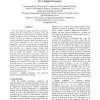108 search results - page 7 / 22 » Similar Code Detection and Elimination for Erlang Programs |
ITCC
2005
IEEE
14 years 1 months ago
2005
IEEE
Abstract: Evidence of some attacks can be manifested by abnormal sequences of system calls of programs. Most approaches that have been developed so far mainly concentrate on some p...
IRI
2006
IEEE
14 years 1 months ago
2006
IEEE
With the rapidly increasing complexity of computer systems and the sophistication of hacking tools and techniques, there is a crucial need for computer forensic analysis technique...
IIE
2006
13 years 7 months ago
2006
Plagiarism in universities has always been a difficult problem to overcome. Various tools have been developed over the past few years to help teachers detect plagiarism in students...
ICSE
2000
IEEE-ACM
13 years 11 months ago
2000
IEEE-ACM
Explicitly stated program invariants can help programmers by characterizing certain aspects of program execution and identifying program properties that must be preserved when mod...
TRIER
2002
13 years 7 months ago
2002
It is known that interprocedural detection of copy constants and elimination of faint code in parallel programs are undecidable problems, if base statements are assumed to execute...

